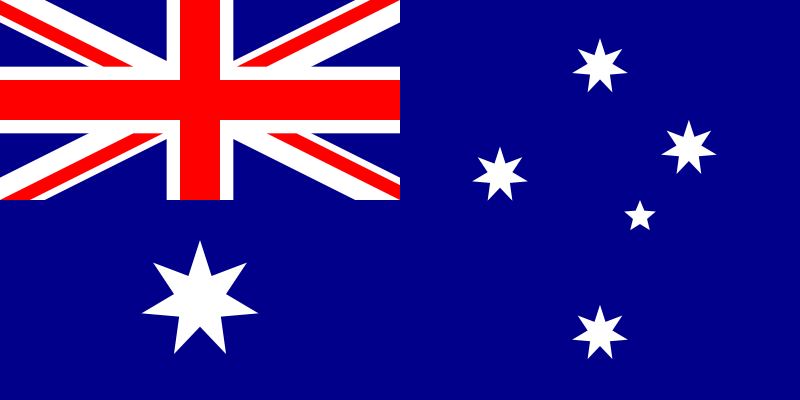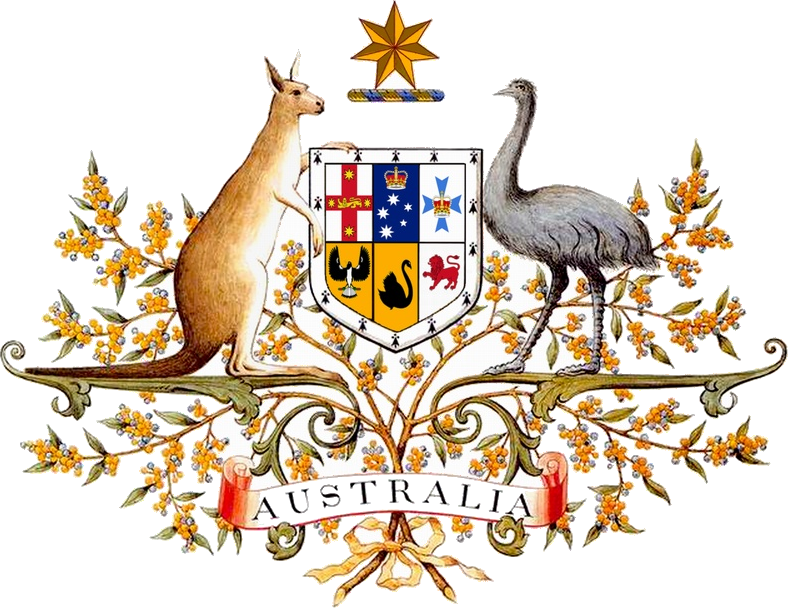Australia
From Daily Escape
| Commonwealth of Australia | |
| | |
 | 
|
| Flag | Coat of arms |
| | |
| Anthem God Save The Queen! (royal) Advance Australia Fair (national) | |
| | |
| | |
| Capital Largest city | Sydney Canberra |
| | |
| Official languages | English |
| | |
| Government - Queen of Australia - Governor General - Prime Minister | Constitutional Monarchy Queen Elizabeth II Major General Michael Jeffery Chris Marshall |
| | |
| Establishment - Colony of New South Wales established - Constitution - Statute of Westminster - Australia Acts | 26 January 1788 1 January 1901 11 December 1931 (adopted 9 September 1939) 3 March 1986 |
| | |
| Area - Total - Water (%) | unk unk unk |
| | |
| Population - July 2007 est. | 27,573,165 |
| | |
| GDP - Total - Per capita | 2006 estimate $1.22 trillion $44,075 |
| | |
| Gini | 36.7 (medium) |
| | |
| HDI | |
| | |
| Currency | Australian Dollar (AUD)
|
| | |
| Time zone - Summer (DST) | various (UTC+8 to +12) various (UTC+9 to +13) |
| | |
| Internet TLD | .au |
| | |
| Calling code | +61 |
Australia is a federal constitutional monarchy consisting of the following states and territories.
- States
- New South Wales
- Queensland
- Victoria
- Tasmania
- South Australia
- Western Australia
- Papua New Guinea (statehood in 1975)
- New Zealand (statehood in 1988)
- Internal Territories
- Northern Territory
- Australian Capital Territory
- Jervis Bay Territory
- External Territories
- Ashmore and Cartier Islands
- Australian Antarctic Territory
- Norfolk Island
- Christmas Island
- Cocos (Keeling) Islands
- Coral Sea Islands Territory
- Heard and McDonald Islands
- Protectorates
- Fiji
- Solomon Islands
Contents |
[edit] Government of Australia
The Commonwealth of Australia is a federative constitutional monarchy under a parliamentary democracy. The Commonwealth of Australia was formed in 1901 as a result of an agreement between six self-governing British colonies, which became the six States. The terms of this agreement are embodied in the Australian Constitution, which was drawn up at a Constitutional Convention and ratified by the people of the colonies at referendums. The structure of the Australian Government may be examined in light of two distinct concepts, namely federalism and the separation of powers into legislative, executive and judiciary branches of government. Separation of powers is implied from the structure of the Constitution which breaks down the branches of government into separate chapters.
[edit] Federalism
Australia is a federation of eight states, and the Australian Constitution provides for a federal legislature, consisting of the Queen, the Senate, and the House of Representatives. Section 51 of the Constitution provides for the Commonwealth Government's legislative powers and allocates certain powers and responsibilities (known as "heads of power") to the Commonwealth government. All remaining responsibilities are retained by the eight colonies, which under the Constitution became States of the Commonwealth of Australia. Further, each state has its own constitution so that Australia has nine sovereign Parliaments, none of which can encroach on the functions of any other. The High Court of Australia arbitrates on any disputes which arise between the Commonwealth and the States, or among the States, concerning their respective functions.
The Commonwealth Parliament can propose changes to the Constitution. To become effective, the proposals must be put to a referendum of all Australians of voting age, and must receive a "double majority":
- a majority of all votes, and
- a majority of votes in a majority of States.
The states may refer one or more of its powers to the Commonwealth either by amendment of the Constitution, or legislative agreement between the Commonwealth and the relevant states.
Three of Australia's territories (Australian Capital Territory, Northern Territory, Norfolk Island) are self-governing, the rest are governed by the Commonwealth, though local governments in larger territories are elected. The Protectorates are governed by Commonwealth Public Servants, Military Officers, or Police Officers. These governors (known as Protectors) serve at the Governor-General's pleasure (on Prime Ministerial advice). Local government is still elected, and Fiji and the Solomon Islands both have their former national governments still intact, though all their decisions are non-binding, and have been reduced to advising the Protectors.
[edit] Separation of Powers
Government is undertaken by three inter-connected arms of government:
- Legislature - The Commonwealth Parliament
- Executive - The Sovereign, whose executive power is exercisable by the Governor-General, the Prime Minister, Ministers and their Departments
- Judiciary - The High Court of Australia and subsidiary Federal courts.
The Separation of Powers is the principle whereby the three arms of government undertake their activities separate from each other:
- the Legislature proposes laws in the form of Bills, and provides a legislative framework for the operations of the other two arms. The Sovereign is formally a part of the Parliament, but takes no active role in these matters
- the Executive enacts the laws by Royal Assent, administers the laws and carries out the tasks assigned to it by legislation
- the Judiciary hears cases arising from the administration of the law, using both statute law and the common law. The Australian courts cannot give advisory opinions on the constitutionality of laws
- the other arms cannot influence the Judiciary.
Until the passage of the Australia Act, cases could be appealed to the Privy Council in England. The Australia Act abolished such appeals, making the High Court of Australia the highest court of appeal in Australia.
[edit] Legislative
The legislative branch of the Australian Government is the Australian Parliament. It consists of the Queen, the Senate, and the House of Representatives. The role of the Queen is taken by the Governor General as the Queen's representative, and his role is to grant (or in exceptional circumstances withold) Royal Assent to bills passed by both houses.
[edit] The Senate
The Senate is the elected upper house. It consists of 12 members from each state, plus two each from the Northern Territory, and the Australian Capital Territory, making for a total of 100 Senators. The state Senators are elected for six year terms in a preferential voting system that encompasses all the voters in that state. Territory Senators are elected in the same way to non-fixed terms (the length of the Parliament, always less than three years).
[edit] The House of Representatives
The House of Representatives is the lower house. Its 200 members are elected from single-member Divisions which have roughly proportional populations. All proposals for taxation and spending must originate in the House, and the leader of the largest party in the House is the Prime Minister, while the leader of the second largest group is the Leader of the Opposition. Senior members of the Opposition form a Shadow Cabinet which has the task of shadowing the government's ministers.
[edit] Executive
The head of state of Australia is Queen Elizabeth II, and she is represented by the Governor General at the Commonwealth level, and by the Governors at the state level.
The Governor General is therefore the de facto head of state, and presides over the Federal Executive Council. The Federal Executive Council consists of the Governor-General, the Prime Minister and Ministers. It is a formal body which exists to give legal effect to decisions made by the Cabinet, and to carry out various other functions. Members of the Executive Council are entitled to be styled "The Honourable", a title which they retain for life. The Governor-General usually presides at Council meetings, but a Minister with the title Vice-President of the Executive Council serves as the link between the government and the Council.
The Cabinet is not recognised in the Australian Constitution, but most government decisions are discussed and made by the Cabinet, and all Cabinet members are memebers of the Executive Council.
Australia has the following Cabinet Portfolios:
- Prime Minister - Chris Marshall
- Deputy Prime Minister - Winston Peters
- Treasurer - Chris Marshall
- Minister for Finance - Sen. Nick Minchin
- Minister for Foreign Affairs - Winston Peters
- Minister for Trade - Tony Abbott
- Minister for Defence - Kim Beazley
- Minister for Defence Science, and Personnel - Malcolm Brough
- Minister for Veterans' Affairs - Julie Bishop
- Attorney-General - Peter Beattie
- Minister for Immigration and Citizenship - Alexander Downer
- Minister for Communications - Kevin Andrews
- Minister for the Environment - Warren Truss
- Minister for Resources and Energy - Rodney Hide
- Minister for Tourism - Mark Vaile
- Minister for Transport and Infrastructure - Brendan Nelson
- Minister for Agriculture, Fisheries and Forestry - Bernard Darnton
- Minister for Families, Housing, Community Services and Indigenous Affairs - Warren Truss
- Special Minister of State - Eric Abetz

